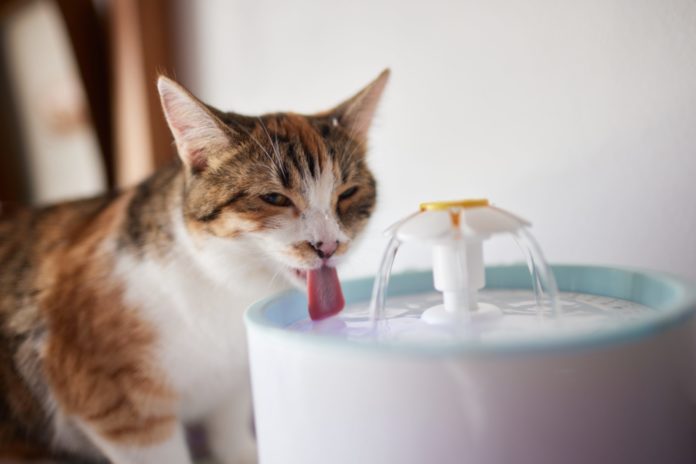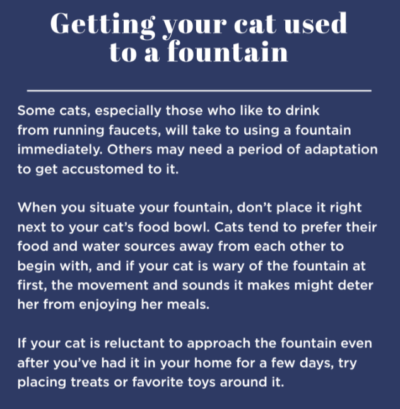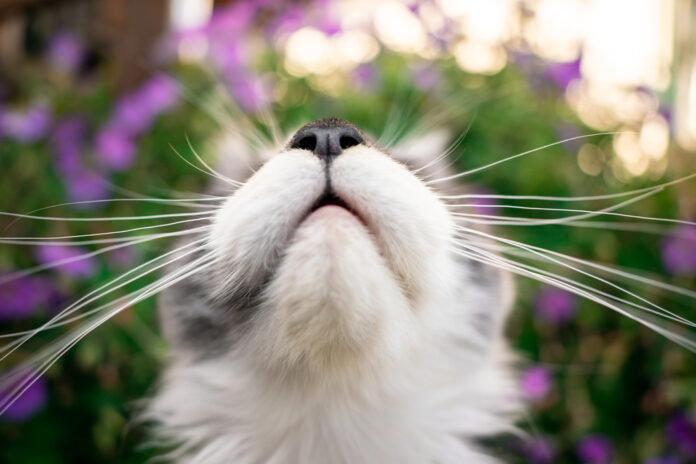Buying a Water Fountain for Your Cat?

Because many cats are attracted to running water, it’s a great way to help encourage them to stay hydrated. Here’s what to keep in mind if you’re considering a water fountain for your own kitty.
Water is critical to keeping your kitty healthy. Lack of water can lead to chronic low-level dehydration, which in turn can lead to urinary tract and kidney problems. If you suspect your cat isn’t drinking enough water, a fountain might prompt her to stay better hydrated.
Low Thirst Drive
Cats as a species don’t have a high thirst drive. This goes back to their origins as desert dwellers, when they relied on moisture from prey animals to satisfy their water requirements. Today, many cats eat processed pet foods, which often don’t contain the moisture they need to stay healthy. Cats who eat commercial dry foods are in particular danger of developing diseases that result from low water intake.
Why Hydration Is Important
Proper hydration can help prevent urinary tract disease and promote healthy kidney function by flushing out toxins. Lack of water can lead to chronic low-level dehydration, which in turn can lead to urinary tract and kidney problems. In fact, water affects everything from nutrient absorption and digestion to circulation and maintaining a healthy body temperature. A properly hydrated body will have an optimal balance of electrolytes, minerals, and fluids. When a cat is dehydrated, she doesn’t just lose water, but also critical electrolytes like sodium, potassium and chloride, which are all required for normal body function.
While cats who eat a raw or canned diet will most likely get sufficient water intake from their food, they should still always have plenty of fresh water available. Fountains are a great way to encourage cats to drink more because many cats are attracted to running water.
What to Look for in a Cat Fountain
Materials
Fountains made from stainless steel or ceramic are preferable to plastic products.
- Even though most fountains are now made from BPA-free plastic, which eliminates concerns about toxicity, plastic can get scratched and harbor bacteria. Additionally, not all plastics are dishwasher safe

- Stainless steel is a better choice and has no toxicity issues. It is easy to clean and can withstand the dishwasher. However, stainless steel should not be scrubbed as the resulting scratches can harbor bacteria. Lesser quality stainless steel may rust.
- The most hygienic choice of material for a fountain is ceramic. Ceramic is resistant to heat, stains and rust, and does not scratch. It also keeps water cooler longer than plastic or stainless steel. The only potential issue with ceramic is lead toxicity, so make sure the fountain you select uses food safe glazes and is from a reputable company. If the company doesn’t disclose that their fountain is food safe, it most likely is not.
Filtration
There are two types of filtration, chemical and mechanical. Chemical filtration is usually achieved by activated charcoal, which absorbs impurities and eliminates odors. It can also improve taste.
Mechanical filtration is simply a barrier that prevents cat hair and debris from entering the pump. In some fountains, this may be a plastic grid. Most fountains use a sponge-like material for mechanical filtration.
Most fountains will use both types of filtration, although a fountain can run without a chemical filter.
Maintenance and Cleaning
 Many cat parents stop using a fountain because cleaning and maintaining it is too complicated. To some extent, your cleaning schedule will depend on how many cats are using the fountain, and how frequently they are drinking from it, but in most cases, the fountain’s bowl should be cleaned daily when you replace the water.
Many cat parents stop using a fountain because cleaning and maintaining it is too complicated. To some extent, your cleaning schedule will depend on how many cats are using the fountain, and how frequently they are drinking from it, but in most cases, the fountain’s bowl should be cleaned daily when you replace the water.
Once a week, the entire fountain needs to be taken apart and cleaned, which is why it’s important to look for models that make this easy. Some manufacturers claim their fountains only need to be cleaned once a month, which is most definitely not enough. How would you like to drink out of a glass that hasn’t been cleaned for a whole month?
Other Features
- If you are sensitive to noise, look for a fountain with a quiet pump. Generally, anything below 30 dB is considered super quiet.
- If you don’t like the sound of running water, look for a fountain with a low spout. It will still have moving water, but you won’t hear dripping as the water hits the bowl.
- Some fountains offer LED lights that illuminate them at night. This can be a fun feature for cat parents but doesn’t really serve a purpose as far as cats are concerned.
Appearance
While your cat won’t care what the fountain looks like, appearance matters. A fountain that’s stashed in a dark corner because it’s ugly probably won’t get used. With so many different models to choose from, you’ll be able to find one that is functional and attractive. Some fountains are true works of art!
Cost
When looking at the price of fountains, don’t just look at the cost of the actual product. Consider also the cost of filters and how frequently the manufacturer suggests replacing them.
A fountain may be just what you need to encourage your cat to drink more water and stay hydrated. Cleaning and maintaining the fountain is part of the equation, but it’s worth it to know you’re helping prevent kidney and urinary tract issues in your kitty.



